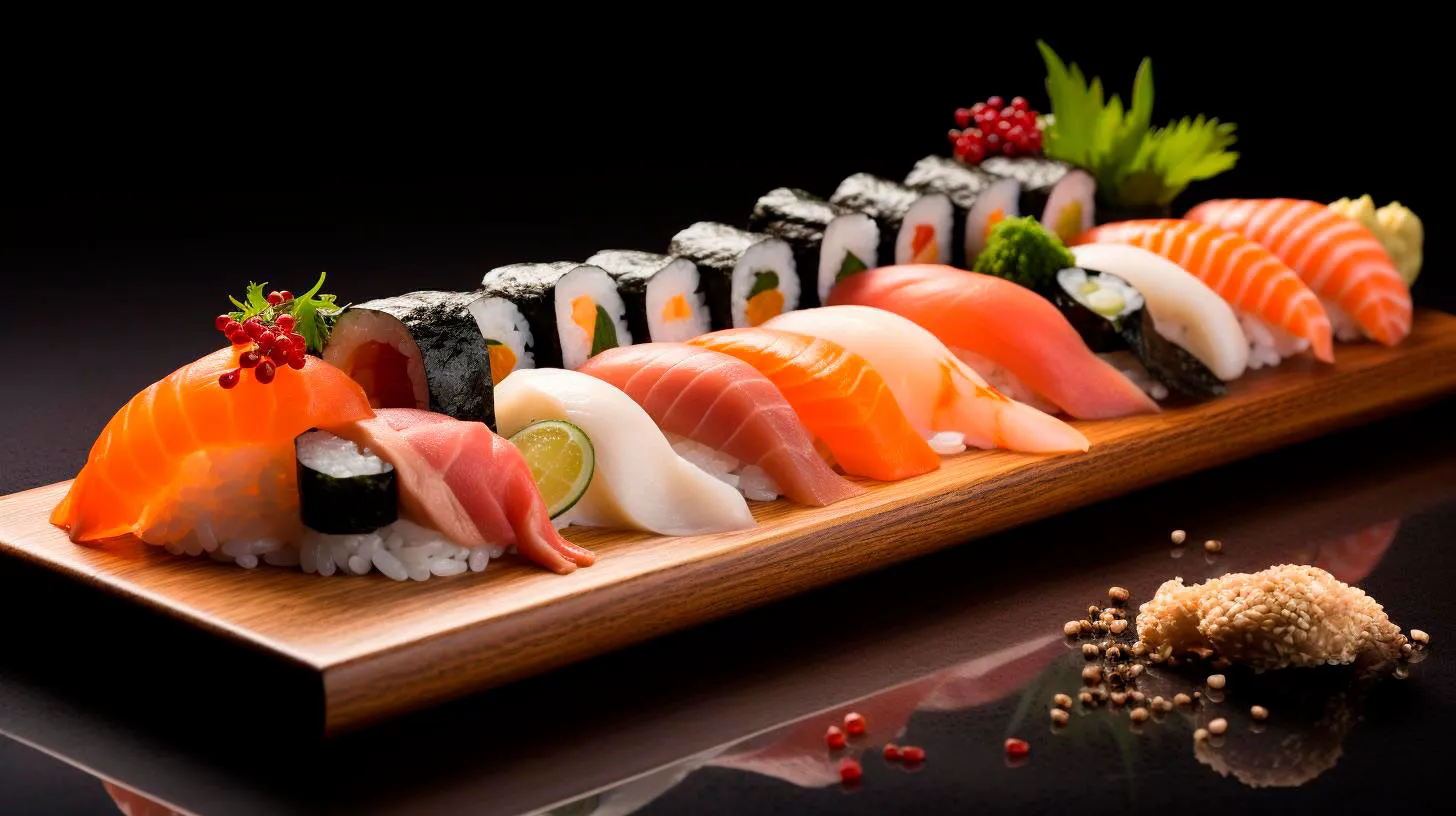Dipping into the Secrets of Soy Sauce
Let’s uncover the hidden depths of this ancient and flavorful elixir.
The History and Origins
Soy sauce dates back over 2,000 years ago in China during the Zhou Dynasty. It was initially used as a way to preserve fish and meat by fermenting them with soybeans and salt. As its popularity grew, soy sauce made its way to Japan and other parts of Asia, where it later transformed into the regional variations we know today.
The Production Process
Soy sauce is made through a two-step fermentation process, involving koji (a type of mold) and brewing. Here are the key steps:
- Steamed soybeans and roasted wheat are mixed and inoculated with koji mold spores.
- The mixture is incubated for several days, allowing the koji mold to convert the starches into sugars.
- The koji mixture is combined with brine (water and salt) and left to ferment for months or even years.
- After fermentation, the liquid is pressed out, pasteurized, and bottled as soy sauce.
Types of Soy Sauce
There are several distinct types of soy sauce, each adding its own unique flavor profile:
- Light Soy Sauce: Also known as “thin” or “regular” soy sauce, it has a light and salty taste. It is often used for dipping, seasoning, and cooking lighter-colored dishes.
- Dark Soy Sauce: This variety is thicker and has a deep, rich flavor. It adds a dark color to dishes and is ideal for marinades, stews, and braised dishes.
- Tamari: Tamari is a type of soy sauce that is typically gluten-free and has a stronger flavor compared to regular soy sauce. It is often used in Japanese cuisine.
- Shoyu: Shoyu is the Japanese name for soy sauce. It is usually made from a combination of soybeans and wheat and is the most common type of soy sauce in Japan.
Health Benefits
Besides its delicious taste, soy sauce offers some health benefits:
- Nutrient-rich: Soy sauce contains essential minerals such as iron, magnesium, and potassium. It also provides small amounts of protein and B vitamins.
- Antioxidants: Due to the fermentation process, soy sauce is packed with antioxidants that help combat oxidative stress and reduce the risk of chronic diseases.
- Heart Health: Some studies suggest that soy sauce may help lower blood pressure and cholesterol levels, contributing to a healthier heart.
- Gut Health: The fermentation process also produces beneficial bacteria and probiotics, which support a healthy gut microbiome.
Culinary Applications
The versatility of soy sauce extends far beyond a typical condiment. Here are some exciting culinary uses:
- Marinades: Soy sauce adds depth of flavor and tenderizes meats when used as a marinade. Combine it with ginger, garlic, and a touch of sweetness for an irresistible marinade.
- Stir-fries: A drizzle of soy sauce can elevate stir-fried vegetables, noodles, or rice dishes to new heights. Its umami flavor enhances the overall taste of the dish.
- Dipping Sauce: Mix soy sauce with a splash of rice vinegar, sesame oil, and chili flakes for a tangy and spicy dipping sauce perfect for dumplings, spring rolls, or sushi.
- Soups and Broths: Adding a small amount of soy sauce to soups, stocks, or broths enhances their savory flavor and brings out the depth of other ingredients.
With its rich history, diverse flavors, and multitude of culinary uses, soy sauce has become a pantry staple for many households. Whether you’re a seasoned chef or an amateur cook, exploring the secrets of soy sauce can open a world of possibilities in your culinary adventures.
So why not grab a bottle of soy sauce on your next grocery run and experiment with this ancient elixir? Your taste buds will thank you!
Mastering the Art of Rice
In this blog article, we will explore the art of rice and provide tips and techniques to help you master this essential culinary skill.
The Importance of Proper Rice Cooking
Cooking rice may seem like a simple task, but achieving perfectly cooked grains can make a significant difference in the final result of your dish. Undercooked or overcooked rice can ruin the texture and taste of your meal. Not only that, but improperly cooked rice can also affect the nutritional value of the dish. Therefore, mastering the art of rice cooking is crucial for anyone who enjoys this grain.
Choosing the Right Rice Variety
The first step towards mastering the art of rice is selecting the right variety for your dish. Each rice variety has its own unique characteristics and cooking requirements. Here are a few popular rice varieties and their key features:
- Basmati Rice: Known for its distinct flavor and aroma, basmati rice is long-grained and commonly used in Indian and Middle Eastern cuisines.
- Arborio Rice: This short-grain rice is primarily used in Italian dishes, especially risotto, due to its ability to absorb flavors and release starch, creating a creamy texture.
- Sushi Rice: With its sticky texture, sushi rice is essential for making sushi rolls, nigiri, and other Japanese dishes.
Proper Rice-Water Ratio
One of the most fundamental aspects of cooking rice is getting the right rice-water ratio. This can greatly impact the texture and quality of the cooked rice. Here are some general guidelines:
- Rinse rice under cold water before cooking to remove excess starch, as this can make the rice sticky. Use a fine-mesh strainer for best results.
- For long-grain rice, such as basmati, use a ratio of 1 cup of rice to 1.5 cups of water.
- For short-grain rice, like sushi rice, increase the water slightly to achieve a stickier texture. A ratio of 1 cup of rice to 1.25 cups of water is a good starting point.
Adjust the ratio based on the desired texture and cooking method. Remember that different rice cookers and stovetop methods may require slight modifications to the ratio.
Mastering the Cooking Process
Once you have chosen the right rice variety and measured the correct rice-water ratio, it’s time to cook the rice. Here are some key tips:
- Stovetop Method: Bring the water and rice to a boil in a covered pot, then lower the heat to a simmer. Cook for the recommended time (as indicated on the rice packaging) without opening the lid.
- Rice Cooker: Add the rinsed rice and measured water to the rice cooker. Follow the manufacturer’s instructions for cooking times and settings.
- Resting Time: Once the rice is cooked, allow it to rest for a few minutes before fluffing it with a fork. This helps the grains to settle and ensures even moisture distribution.
Remember, practice makes perfect. It may take a few attempts to find the perfect cooking time and technique that suits your preferences and equipment. Experiment and make adjustments as needed.
Key Takeaways
Cooking rice perfectly is an art that can greatly enhance your meals. Here are some key takeaways to remember:
- Choose the right rice variety for your dish.
- Rinse the rice before cooking to remove excess starch.
- Follow the recommended rice-water ratio for the desired texture.
- Master the cooking process, whether using stovetop or a rice cooker.
- Allow the cooked rice to rest before serving.
By following these tips, you will be well on your way to mastering the art of rice. Enjoy experimenting with different rice varieties and exploring new culinary possibilities!
Unveiling the Delicate World of Nori
The Origins of Nori
Nori, scientifically known as Porphyra, has been a staple in Japanese cuisine for centuries. It is believed to have originated in Japan around the 8th century, where it was initially consumed by royalty and samurais due to its scarcity. However, as time went on, nori became more accessible and eventually made its way into the mainstream diet.
Today, nori is not only consumed in Japan but is globally recognized as a versatile ingredient. It is most commonly used to wrap sushi rolls, providing a delicious crunch and enhancing the overall flavor. Apart from sushi, nori is also used in soups, salads, and even as a seasoning.
The Nutritional Powerhouse
While nori is known for its unique taste and culinary uses, its nutritional profile is what truly sets it apart. This seaweed is packed with essential vitamins and minerals, making it a healthy addition to any diet. Let’s take a closer look at its key nutritional benefits:
- Rich in iodine: Nori is an excellent source of iodine, a vital nutrient that supports thyroid function and regulates metabolism.
- Abundant in minerals: Nori is packed with minerals like iron, calcium, magnesium, and potassium, which are essential for maintaining overall health.
- Loaded with vitamins: This seaweed is a great source of vitamins A, C, and E, which contribute to healthy skin, improved immunity, and enhanced vision.
- Low in calories: Nori is incredibly low in calories and fat, making it an excellent choice for weight-conscious individuals.
With such a powerhouse of nutrients, incorporating nori into your diet can have numerous health benefits. From boosting your immune system to supporting thyroid function, this superfood is a game-changer for your well-being.
Nori and its Environmental Impact
As we become more conscious of our environmental footprint, it is necessary to examine the impact of the products we consume. Fortunately, nori comes with several eco-friendly advantages:
- Sustainable cultivation: Nori is cultivated using sustainable farming practices that minimize the environmental impact and ensure its long-term availability.
- Carbon sequestration: Seaweeds like nori have the unique ability to absorb carbon dioxide from the atmosphere, helping mitigate the effects of climate change.
- Zero waste: The production process of nori leaves minimal waste, making it an environmentally friendly food choice.
By choosing nori as part of your diet, you are not only benefiting your health but also contributing to a more sustainable future for our planet.
Key Takeaways
As we conclude our journey into the delicate world of nori, let’s recap the key takeaways:
- Nori is a versatile and nutritious seaweed that has been consumed in Japan for centuries.
- It is rich in essential vitamins, minerals, and iodine, making it a powerhouse of nutrients.
- Incorporating nori into your diet can offer various health benefits and support overall well-being.
- Nori cultivation follows sustainable practices and has a minimal environmental impact.
So, the next time you enjoy a mouth-watering sushi roll or savor a bowl of miso soup, take a moment to appreciate the delicate and intricate world of nori. With its unmistakable flavor and remarkable nutritional benefits, this seaweed continues to captivate taste buds and nourish bodies worldwide.
The Power of Fresh Seafood
In this article, we explore the many advantages of incorporating fresh seafood into your diet.
1. Rich in Omega-3 Fatty Acids
One of the standout features of fresh seafood is its high omega-3 fatty acid content. These fatty acids are considered essential for our bodies as they cannot be produced naturally. Eating seafood regularly can help lower the risk of heart disease, reduce inflammation, improve brain function, and even boost mood and mental health.
2. Abundance of Essential Nutrients
Seafood is not only a great source of omega-3 fatty acids but also packed with essential nutrients. It is rich in vitamins such as vitamin D, vitamin B12, and vitamin A. These vitamins play crucial roles in maintaining bone health, supporting the immune system, and promoting good vision, respectively. Additionally, seafood is an excellent source of minerals like iodine, selenium, and zinc, which are vital for overall well-being.
3. Low in Fat and High in Protein
If you are watching your waistline but still want to indulge in delicious food, fresh seafood is what you need. Unlike meat and poultry, seafood is relatively low in fat, making it a healthy option. Additionally, it is an excellent source of high-quality protein, which helps in building and repairing tissues, promoting muscle growth, and boosting metabolism. With seafood, you can enjoy a satisfying meal without worrying about unnecessary calories.
4. Source of Antioxidants
Antioxidants are essential compounds that help protect our bodies against damage caused by harmful molecules called free radicals. Fresh seafood, such as fish and shellfish, contains a variety of antioxidants like astaxanthin, selenium, and vitamin E. These antioxidants can help reduce the risk of chronic diseases, including heart disease and certain types of cancer.
5. Versatile and Delicious
Seafood offers a wide range of options that can suit any palate or preference. From delicate white fish and succulent shrimp to rich salmon and flavorful mussels, there is something for everyone. Seafood can be grilled, baked, fried, or even eaten raw in sushi, making it incredibly versatile. With its unique flavors and textures, fresh seafood can elevate any dish and leave you craving for more.
Key Takeaways
- Fresh seafood is packed with omega-3 fatty acids, essential nutrients, and antioxidants
- Regular consumption of seafood can offer numerous health benefits, including improved heart health and brain function
- Seafood is a great source of high-quality protein and is low in fat, making it a healthy option
- Antioxidants found in seafood can help protect the body against chronic diseases
- The versatility and deliciousness of seafood allow for endless culinary possibilities
So, whether you are a seafood lover or looking to incorporate healthier options into your diet, fresh seafood should undoubtedly be on your plate. Its exceptional taste, combined with its abundance of health benefits, makes it a true powerhouse in the world of culinary delights. So go ahead and dive into the power of fresh seafood!
Sources:
- https://www.ncbi.nlm.nih.gov/pmc/articles/PMC4404917/
- https://www.healthline.com/nutrition/12-omega-3-rich-foods#section6
- https://www.healthline.com/nutrition/why-is-fish-good-for-you#section1



